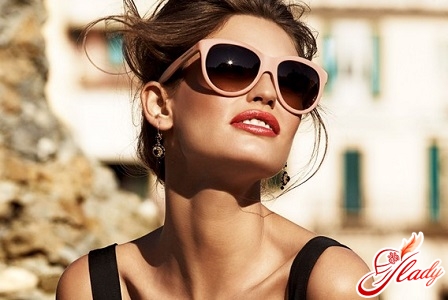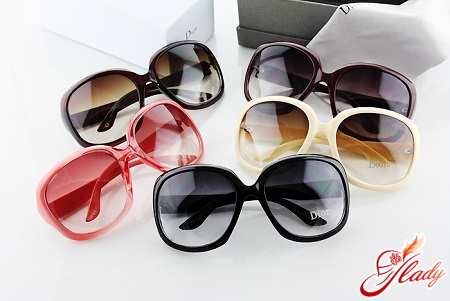 Sunglasses are a must-have of any respectedyourself a lady. This is a stylish accessory with a huge number of undeniable advantages. When we choose glasses from the sun, first of all, pay attention to the fashion trends and the appearance of the product. Not many people understand that a stylish frame or purple lenses are not the main points when choosing glasses. Let's consider the basic practical recommendations, which it is desirable to adhere to when choosing sunscreen accessories.
Sunglasses are a must-have of any respectedyourself a lady. This is a stylish accessory with a huge number of undeniable advantages. When we choose glasses from the sun, first of all, pay attention to the fashion trends and the appearance of the product. Not many people understand that a stylish frame or purple lenses are not the main points when choosing glasses. Let's consider the basic practical recommendations, which it is desirable to adhere to when choosing sunscreen accessories.
Choose the right glasses: the basic steps
- "0" - lenses let light pass through 79-100%, they provide minimal protection from exposure to sunlight.
- "1", "2" - light transmission is 45-79 or 18-45%. This model - an excellent option for urban conditions and daily wear.
- "3" - the lens passes the rays by 7-20%. These glasses are good for a beach season and recreation outside the city.
- "4" - light transmittance of lenses is 3-7%. This filter is considered the most dark, it protects the retina well in excessively hot solar countries and in high mountains.
The glasses of the last two categories provide the most high-quality protection against the effects of infrared and ultraviolet rays.
Lenses: what are they?
Most often sunglasses are produced withordinary lenses of all kinds of colors. But over time, specimens with "heaped" coatings began to appear. Very often, customers do not quite understand the meaning of concepts: lenses with a "photochromic" or "polarized" coating. Let's see what's what.
- Polarization coating
This coating protects against blinding glare andimproves contrast. Glasses with such lenses are ideal for motorists. To check whether the proposed model has a polarization coating, it is enough to use the services of the optics store, where on a special screen or a sticker you can see an image that is not visible to the naked eye.
- Anti-glare (antireflection) coating
Removes "parasitic images" and highlightsthe back of the glass. What is meant? It happens that we see inside the glasses the reflection of our eyes or objects that are located behind us. "Parasitic images" significantly worsen the clarity of the vision, especially when driving a car in the dark. This coating eliminates this problem.
- Photochromic coating
Such lenses are also called chameleons, since theychange color (lighten or darken) depending on the lighting. Models with photochromic coating are very convenient for people who have vision problems, but do not want to change glasses over and over again, going into the room or walking outdoors.
- Mirror Coating
This lens is more darkened than the usual version. They divert heat rays and are recommended for skiing or swimming. And a couple of more moments. If you put on your favorite glasses with colored lenses, and the world instantly changed color, know: before you is a real fake. Brand lenses correctly transmit colors, only slightly changing their hue. Violation of the usual color for us in favor of one of the colors very dispels attention and tires the eyes. In addition, accurate color perception is very important for some categories of people, for example, motorists, so colored lenses are not suitable in all situations. The most optimal is gray (from light shades to deep) and brown. Gray provides a clear real perception, and brown - contrast. Drivers are advised to choose a yellow color, this filter does not strain the eyes and helps to better perceive space. Orange lenses reduce the blinding effect of light in the dark, while green lenses add contrast to the surroundings in the absence of sufficient light, and also protect from bright rays. Avoid lenses, the world in which you seem purple or blue (literally). In such glasses, you risk losing your eyesight in almost one summer. The predominance of the blue and violet parts of the spectrum inhibits the motor skills and the pace of human thinking, and the blue-blue enhances the effects of light diffusion, which causes the danger of glare, for example, from the headlights of oncoming vehicles. 
Glass or plastic?
Lenses for sunglasses are made of threematerials: glass, acrylic and polycarbonate plastic. Glass goggles are the safest option, as they do not pass the ultraviolet rays. But over time, plastic slowly replaced the glass, because it is more practical and easier. Glasses with plastic lenses let the ultraviolet pass, and the blackout deceives the eyes, so that the pupil expands and takes the entire negative solar wave to itself. Over time, this effect can lead to poor vision and clouding of the lens. Plastic glasses are desirable to buy with additives that help to delay radiation. During the purchase, pay attention to the label, the most harmful rays are type B, therefore the products should be protected from them almost completely. In addition, if the label refers to the boundary wavelength, it is better to give points with a value of about 400 nm.
Choose a frame
The most practical material for manufacturingThe rim was always considered nylon. It bends well and can return to its original position. What swings plastic, then these frames quickly break, so it's better if the inside of the plastic frame is also metal. When choosing glasses, pay attention to the quality of the frame itself. A couple of times open the bow, bend them. A good frame should be elastic and not rigid. Check the cogs with which the hands are attached, whether they are well screwed. Finally, try on the glasses. Are they comfortable, do not they shake hands, do they squeeze against the bridge of the nose? If you cant head, glasses should not slide to the tip of the nose or even fall off. By the way, if the frame is initially tough and uncomfortable, it will remain so, do not hope that the glasses are "carried".
Which glasses are suitable for different types of face?
When we reflect on the question: "How to choose sunglasses?", Weigh all the pros and cons, select a firm and model, we involuntarily think about what kind of option suits my type of face. Undoubtedly, with you there was a situation when the showcase is just an ideal model, but you do not go and everything. Let's figure it out.
- Oval face
A universal type, which is suitable for absolutely any form of glasses. And to avoid disproportions, the width of the product should be the same as the widest part of the face.
- Round face
This type of contra-indicated glasses with glasses inThe shape of the ovals, as they will round the face even more. In this case it is better to give preference to rectangular forms or a variant in the form of a cat's eye. With regard to the frame, it will be good to look glasses with a thin rim or even without rim.
- Square face
Here, on the contrary, glasses of an oval shape or with a rounded frame are ideal. It is advisable not to choose rectangular models to further aggravate the corners.
- Stretched out (long) face
In this case, the task is not to lengthen the face, but visually to make it smaller. In this you will be helped by glasses, stretched in width or with a wide frame.
- Triangular face (heart)
To soften the pronounced cheekbones, it is better to choose glasses without oval or round rim.
Read the label
As well as to any other product, to sunscreenThe glasses are attached with a label. How to understand what is written there? If you see the inscription, for example, "blocks at least 95% UVB and 60% UVA", this means that the glasses do not let 60% of ultraviolet pass better type A and 95% type B, that is, the product protects against the two most harmful types of emissions . The inscription "plastic" means that the product is made of plastic. Pay attention to the name of the company, the country of manufacture. And to check whether genuine glasses, you can compare the name of the brand on the lens or the inside of the bow with the name on the label. In addition, each brand produces its products in branded boxes.
How to care for sunglasses
To keep your purchase long, keepits correct. You can buy a semi-rigid cover or hard case. Do not put glasses on the table or any other surface with lenses down, as they can easily get dirty and scratch. Do not forget to wipe the lens with fine suede or a fleecy cloth. These materials very gently clean the lens from dirt. Regardless of the degree of darkening of the lenses, it is not recommended to look at the sun, and if the skin around the eyes still tans when you wear the glasses, it's a beacon that they need to be changed. Sunglasses should not only be a beautiful accessory, but also a good protection against radiation.









